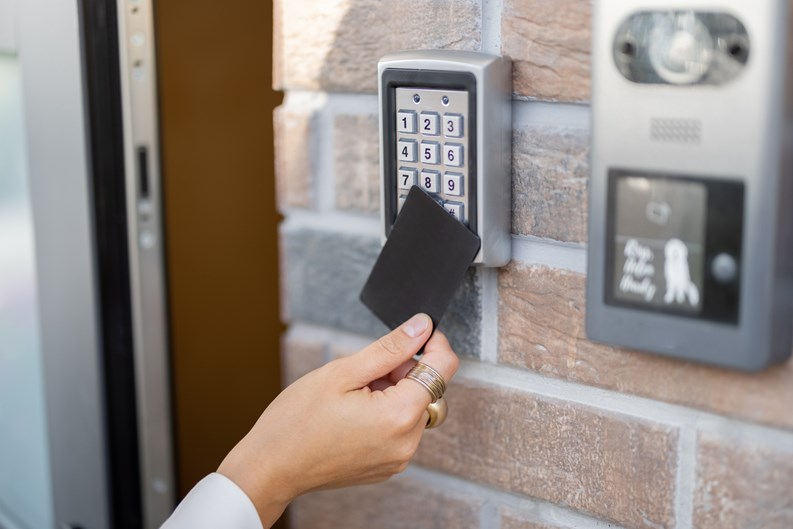Unless you live in Mayberry (and maybe even if you do), chances are you wouldn’t be comfortable leaving your house or going to bed and just leaving your front doors unlocked. Nor would you likely approve of anyone who passed by your home being able to just come in uninvited and roam around unescorted. Despite an uptick in recent years, U.S. crime levels—even in big cities—are historically low overall. But that doesn’t mean that security isn’t a major concern for boards and residents alike. Condos and HOAs still need to secure their properties and control who’s allowed to go where.
Fob Life
Security technology follows security needs—and today, that path usually involves electronic access. According to Bob Maunsell, CEO of Electronic Security Group in West Boylston, Massachusetts, when it comes to condo and HOA living, electronic access usually means key fobs. “Anyone who is in the process of refinancing or doing any major capital improvements is installing keyless entry systems,” says Maunsell. “Everyone is moving toward key fobs. They’re also doing intercom upgrading and video surveillance.”
Lack of that type of security tracking is a major factor leading buildings and associations to replace old metal key systems with electronic fob systems. “There’s no good way to keep track of old-fashioned mechanical keys,” says Maunsell. “With keyless entry, you know who has entered the building and at what time. You can disable a fob when it’s lost, or when a tenant moves out. It’s much easier than having a locksmith come and change the lock.” Changing a lock on an entry door also requires replacing what could be dozens or even hundreds of keys. Electronic technology simply eliminates that problem.
It also saves money. Tony Dahlin, a security expert and owner of Bullis Lock Co. in Chicago, Illinois, says, “Fob popularity has really grown as the price has dropped. [They’ve] long been popular in the commercial sector, but with the price dropping, condos and apartment buildings are increasingly using the technology. If you hand somebody a [mechanical] key and they don’t return it, you have to change the locks. They can make duplicates of the missing key, and you don’t know who has access to your building. With fobs, that can’t happen—they give you control over who enters, and when, and eliminate the need for a physical key. If a fob is lost, you just go into the software and deactivate it without affecting anyone else’s usage.”
How We Got Here
The first big move away from physical keys was in the early 1990s, with the introduction of Dallas chip keys, also known as ‘transponder keys.’ They were originally used as a car-key technology and contain a very small computer chip inside that sends an identifying message to authenticate the key for the lock.
Today, the latest incarnation of this tech is often baked right into newly-built buildings of all types, commercial, industrial, and residential alike. “If it’s new construction, say, within the last five years,” says Maunsell, “buildings have been designed with keyless entry in mind, in conjunction with entry video security and intercom systems.”
And as it happens, these old-model chip keys are often compatible with today’s fob systems—though they may require a technology update. “Older existing sites may have dated keyless entry systems,” says Maunsell. “We run into this a lot. We simply do an update of their system.”
In cities where there are literally thousands of older residential buildings with only mechanical, key-and-cylinder locking systems, retrofitting is handled a little differently. When an older building wants to upgrade their access control, “we’re not replacing the key system,” says Barack Ron, CEO of Vertex Security in New York City. “We’re adding an additional layer of security with the fob system. The owner replaces the cylinder of the existing lock and keeps the corresponding keys. He issues a new fob to each resident. They begin using the fob system, which can be paired with various phone-based apps for further identification of visitors, delivery workers, and so forth, if desired. Fobs are very flexible. Say you have a roof deck, and you want to limit access after 11:00 in the evening. You can program the fobs for that.”
Benefits & Drawbacks
If ever lost, damaged, or compromised, “fobs can be replaced virtually immediately,” says Dahlin. “It’s done with a keystroke in system software and a replacement fob.” The process can be done from almost anywhere where there’s access to the internet, which eliminates the reliance on finding an available locksmith (and the often exorbitant expense of summoning a professional during off-hours or on a weekend). Maunsell points out that many traditional locksmiths are now getting training in fob technology.
Like mechanical keys, each fob is unique to the individual it’s assigned to. In a multifamily context, usually two fobs are issued to each apartment, but if more are needed they can easily be created. Each is individually coded and recognizable, so if your teenager swears he was at school—but was actually at home gaming—you can check the key fob log and present him or her with the receipts!
Parental peace-of-mind notwithstanding, fobs can also be used to solve crimes far more serious than a kid staying home unauthorized. They leave a digital ‘fingerprint,’ which can be extremely useful to law enforcement in some situations. For example, Maunsell relates an incident that occurred in Massachusetts where a fob was critical in solving a murder: A couple involved in a messy separation lived in a building with a fob entry system. The husband had been kicked out of the apartment, and there was a restraining order forbidding him from coming within 300 feet of his estranged wife. Tragically, the husband used his still-active fob to slip back into the building, and killed his estranged wife. Horrible as it was, the case was closed quickly; the husband’s fob left an electronic fingerprint that included not only his identification, but the exact time of his entry. He was immediately apprehended and the case solved.
Fob systems are also easily integrated with other forms of technology, and can be incorporated with a wide array of surveillance systems and phone apps. Dahlin explains that if you have a wifi connection, you can control access even better and integrate heating and lighting controls in one holistic system. Fob systems also eliminate the need for residents or staff members to carry a heavy, bulky ring with multiple metal keys, providing them with one item that will open all the doors in one building, including machine rooms, storage areas, garages, and adjacent parking facilities.
Fob systems also provide the ability to grant temporary access, which can come in very handy for contractors and work crews doing short-term or even extended projects on-site. A fob can also contain an ‘alert’ that will send a notification when it’s being used. That lets property staff, administrators, or managers know when someone who had the fob may be trying to gain entrance without permission, or outside of approved hours. Fobs are flexible and can be programmed down to hours. Old fobs can be easily reassigned to new owners or different points of access.
Useful as they are, however, key fobs do have their drawbacks. According to Ron, no electricity means no keyless entry—because fobs will not work during a power outage. So boards and managers need to have a backup plan, says Stuart Halper of Impact Management, which has offices throughout the New York area. “There aren’t a lot of options, though,” he laments. “Basically [in the event of an outage], you need the super to man the front door to keep it open and under surveillance.” In extreme cases like 2012’s Superstorm Sandy in which electrical power was out for days all along the East Coast, “a backup battery-powered generator wouldn’t work either,” Halper says. “The battery wouldn’t last that long. So you still need the super.”
Climate is another consideration. In an arid climate like Nevada’s, extremes in temperature can have an effect on the function of fob-based systems. “Because of the heat and cold,” says a representative with 24/7 SuperTech Locksmith, which services the Las Vegas valley, “you can have a problem. The fobs may not work. With conventional keys you don’t have that problem.”
And while not as acute, one other major drawback could still be critical. In conjunction with apps on your smartphone, fob systems can be synchronized to provide remote access from almost anywhere. You could be on vacation in the Caribbean, and if someone wants to be buzzed into your building, you can buzz them in through a phone call. That may sound great—and in many ways, it is—but these apps don’t necessarily come with video capability, and that’s the big drawback. You might buzz in someone you didn’t want there. “Old-fashioned buzzer systems are secure,” says Maunsell, “in the respect that you only buzz someone in if you’re in your apartment. With phone entry, you could be anywhere—and that’s less secure.”
Price
Dahlin says the cost of fob systems is dropping thanks to both the technology becoming more accessible and the increasing demand on the part of residents, boards, and property managers. “People want this,” he says. A very simple system can cost under $700 to install and get up and running. The cost of entry is lowest for new construction, where a fob system and any other complementary technology system are installed during the build-out of the property. Retrofits of older buildings without any existing technology are more labor intensive, and therefore more expensive. Such projects may also require extensive physical alterations to run wires, components, and other equipment throughout the property.
For buildings and associations looking to retrofit their properties with key fob systems, Maunsell recommends installing a fob system with a unified platform, which is the most complete iteration of the technology. That platform generally includes keyless entry, surveillance, and intercom—one program on one server on one platform.
So while we may mourn the days when everyone just left their doors open, we can also rest easier now, knowing that at least some forms of technology may have made us a little safer.
A J Sidransky is a staff writer/reporter for CooperatorNews, and a published novelist.







Leave a Comment